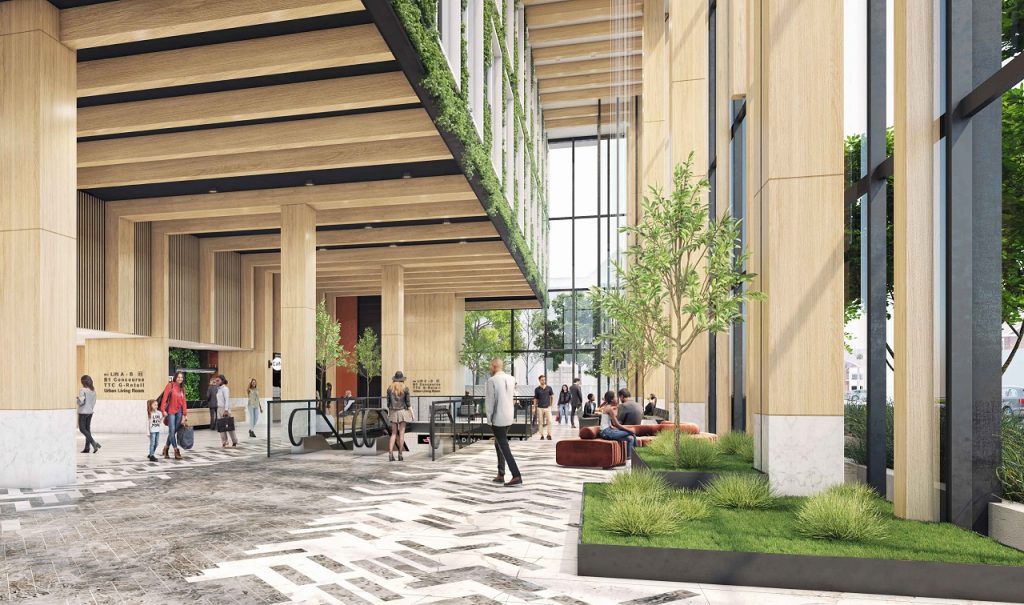Community benefits support Indigenous art and design

By Carly Penrose
The new 35-storey high rise planned for the northwest corner of the Bloor and Spadina intersection has been a long time coming. The development, planning, and community consultations have been ongoing for four years. Now, with only two full council meetings before the fall election, community organizations and developers have had the opportunity to discuss how to do something tangible with the public space in the building to support the community that surrounds it.
Indigenous-led organizations, city staff, BIA members, resident organizations, and developers have come together to discuss how the community benefit funds from the development can support the community around the intersection.
“When we started to get to the discussion around community benefit,” said Councillor Mike Layton (Ward 11, University-Rosedale) who has hosted many of the consultation meetings for the project, “there was a real push from community associations to ensure we looked at the community benefit through the lens of reconciliation.”
The community benefit conversation can only happen because of a development rule called Section 37. Section 37 is a municipal bylaw that requires developers who plan to construct buildings that fall outside of typical zoning laws for the area, to pay a fee to give back to the surrounding community and to account for additional costs associated with more density.
By fall 2022, the Section 37 benefit will be no more. It will instead be replaced by the Community Benefits Charges (CBC) legislation from the provincial government. The new bylaw won’t be drastically different from Section 37, but it is less flexible and limits the types of projects the funds can be spent on. This upcoming change means the decision about how to spend the funds for the Bloor and Spadina development must be made before the council meeting in July.
In this case, the community and local agencies surrounding the Bloor and Spadina intersection expressed a desire to keep the unique history of the place at the forefront of any plans.
“It’s something of a gathering and meeting space. It offered safety and connection,” said Pamela Hart, Executive Director of the Native Women’s Resource Centre, of the intersection. “To redesign with consideration of the benefit to the community, there must be a deeply rooted understanding of what was there before. If not, it can eliminate the community.”
Layton says developers, in large part, heard the community’s concerns and wishes. They worked closely with the Indigenous-owned and operated firm, Two Row Architect, to integrate Indigenous knowledge and heritage into the way the building will be built and they have consulted with nearby organizations to ensure the public space in the entryway to the building will be what developers call an “urban living room.”
The “urban living room” will be a glassed-in atrium and a public space for anyone to use. Layton says it’s a “place that they expect people to gather, to interact.” The living room will serve as a lobby for the housing units in the building, but will also contain office space, retail opportunities and a path to the Spadina subway station.
The living room will be the site of the community benefits project funded through Section 37. Indigenous leaders, in meetings about the development, were clear that any contribution from developers must have real benefits.
“It has to go toward something tangible,” said Hart. “It has to be housing units. It has to be office space. It has to be something the community owns and can call their own, not just visible representation in a building that doesn’t offer anything tangible to give back or enhance our community.”
While Layton said the city cannot compel developers to include affordable units in the building, developers agreed to provide opportunities for office and retail space, as well as fund visible and prominent Indigenous-led art in the space.
Developers and city planners have expressed a desire to make the space a truly open and public one, and they plan for it to operate at the same hours as the TTC, rather than closing when the retail stores lock up for the night. This means there will be challenges monitoring a public place like this, but for now, the focus is on finding and securing spaces within the living room for Indigenous-led groups.
There are more development applications for the other corners of the Bloor and Spadina intersection which means there will be more opportunities to engage meaningfully with Indigenous-led groups and create spaces for their communities.
The developer declined to comment for this news story.
READ MORE:
- NEWS: Community input changes Bloor/Spadina build (Mar. 2021)
- NEWS: New tower for Bloor and Spadina (Jan. 2020)
- DEVELOPINGS: Annex area developments loom (Jan. 2020)
- NEWS: Plans for a “slender” building (August 2019)
